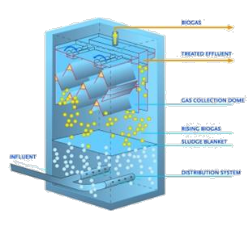BIOPAQ®UASB
In the BIOPAQ®UASB bioreactor, organic compounds are converted to biogas by bacteria in the absence of air. In this way, effluent discharge costs are reduced and at the same time green energy is produced.

The Upflow Anaerobic Sludge Blanket (UASB) process is a frequently applied method in the biological treatment of industrial effluents. Paques has applied the BIOPAQ®UASB technology for more than twenty years and has standardized the reactor into a modular system. Nearly four thousand BIOPAQ® modules are in operation worldwide, treating 1,760,000 m3 of effluent per day. One module has a capacity equivalent to about 1 tonne COD/day (e.g. 15 - 20 m3/hr). This modular approach allows to configure any specific layout and capacity requirement.
BIOPAQ®UASB technology is applied to treat a large variety of industrial and municipal effluents from food, beer and beverage to pulp & paper, chemical and municipal sewage. The modules are available through a worldwide network of licencees.
Additionally, a retrofit programme is available for existing UASB installations. Paques not only has a lot of experience in updating Paques’ installations, but also in improving products of other suppliers.
Advantages of BIOPAQ®UASB
- Very efficient COD removal
- Production of biogas, a sustainable source of energy
- Modular system
- Small reactor height
- Corrosion-free design: ten year guarantee
- Fully accessible for inspection and cleaning
- Closed system: no odour emissions
| Typical influent characteristics | |
| Characteristic | Influent specification |
| COD level | 1,000 to 20,000 mg COD/l |
| Loading rate | 10 - 15 kg COD/m3/day |
Working principle
The success of the BIOPAQ®UASB bioreactor is based on the so-called three-phase separator. It enables the reactor to separate gas, water and sludge mixtures under high turbulence conditions. This allows for compact designs.
The patented BIOPAQ®UASB design has multiple gas hoods for the separation of biogas. As a result the extremely large gas/water interfaces greatly reduce turbulence, making relatively high loading rates of 10 – 15 kg/m3.day possible. Separation in the BIOPAQ®UASB requires only 1.0 meter of height, which prevents flotation effects and, consequently, floating layers.
BIOPAQ®UASB cases
-
Over 25 years of smoothly running wastewater treatment at a ...
-
Lifelong wastewater treatment with UASB retrofitting ...
-
Frozen food production: closed loop installation reduces wat...













